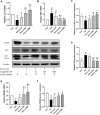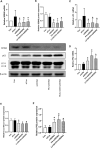GLP‑1 receptor agonist protects palmitate-induced insulin resistance in skeletal muscle cells by up-regulating sestrin2 to promote autophagy
- PMID: 37296162
- PMCID: PMC10256699
- DOI: 10.1038/s41598-023-36602-6
GLP‑1 receptor agonist protects palmitate-induced insulin resistance in skeletal muscle cells by up-regulating sestrin2 to promote autophagy
Abstract
In this study, we aimed to determine whether liraglutide could effectively reduce insulin resistance (IR) by regulating Sestrin2 (SESN2) expression in L6 rat skeletal muscle cells by examining its interactions with SESN2, autophagy, and IR. L6 cells were incubated with liraglutide (10-1000 nM) in the presence of palmitate (PA; 0.6 mM), and cell viability was detected using the cell counting kit-8 (CCK-8) assay. IR-related and autophagy-related proteins were detected using western blotting, and IR and autophagy-related genes were analyzed using quantitative real-time polymerase chain reaction. Silencing SESN2 was used to inhibit the activities of SESN2. A reduction in insulin-stimulated glucose uptake was observed in PA-treated L6 cells, confirming IR. Meanwhile, PA decreased the levels of GLUT4 and phosphorylation of Akt and affected SESN2 expression. Further investigation revealed that autophagic activity decreased following PA treatment, but that liraglutide reversed this PA-induced reduction in autophagic activity. Additionally, silencing SESN2 inhibited the ability of liraglutide to up-regulate the expression of IR-related proteins and activate autophagy signals. In summary, the data showed that liraglutide improved PA-induced IR in L6 myotubes by increasing autophagy mediated by SESN2.
© 2023. The Author(s).
Conflict of interest statement
The authors declare no competing interests.
Figures







Similar articles
-
Sestrin 2 induces autophagy and attenuates insulin resistance by regulating AMPK signaling in C2C12 myotubes.Exp Cell Res. 2017 May 1;354(1):18-24. doi: 10.1016/j.yexcr.2017.03.023. Epub 2017 Mar 12. Exp Cell Res. 2017. PMID: 28300563
-
Liraglutide ameliorates palmitate-induced insulin resistance through inhibiting the IRS-1 serine phosphorylation in mouse skeletal muscle cells.J Endocrinol Invest. 2018 Sep;41(9):1097-1102. doi: 10.1007/s40618-018-0836-x. Epub 2018 Jan 27. J Endocrinol Invest. 2018. PMID: 29374854
-
The GLP-1 receptor agonists exenatide and liraglutide activate Glucose transport by an AMPK-dependent mechanism.J Transl Med. 2016 Jul 30;14(1):229. doi: 10.1186/s12967-016-0985-7. J Transl Med. 2016. PMID: 27473212 Free PMC article.
-
Effects of inhibition of serine palmitoyltransferase (SPT) and sphingosine kinase 1 (SphK1) on palmitate induced insulin resistance in L6 myotubes.PLoS One. 2013 Dec 23;8(12):e85547. doi: 10.1371/journal.pone.0085547. eCollection 2013. PLoS One. 2013. PMID: 24376889 Free PMC article.
-
Transcription factor EB enhances autophagy and ameliorates palmitate-induced insulin resistance at least partly via upregulating AMPK activity in skeletal muscle cells.Clin Exp Pharmacol Physiol. 2022 Feb;49(2):302-310. doi: 10.1111/1440-1681.13600. Epub 2021 Oct 21. Clin Exp Pharmacol Physiol. 2022. PMID: 34614219
Cited by
-
Recent advances in understanding the mechanisms in skeletal muscle of interaction between exercise and frontline antihyperglycemic drugs.Physiol Rep. 2024 Jun;12(11):e16093. doi: 10.14814/phy2.16093. Physiol Rep. 2024. PMID: 38845596 Free PMC article. Review.
-
Pharmacologic Treatment of Obesity in adults and its impact on comorbidities: 2024 Update and Position Statement of Specialists from the Brazilian Association for the Study of Obesity and Metabolic Syndrome (Abeso) and the Brazilian Society of Endocrinology and Metabolism (SBEM).Arch Endocrinol Metab. 2024 Nov 25;68:e240422. doi: 10.20945/2359-4292-2024-0422. eCollection 2024. Arch Endocrinol Metab. 2024. PMID: 39664998 Free PMC article. Review.
-
Autolysosomal Dysfunction in Obesity-induced Metabolic Inflammation and Related Disorders.Curr Obes Rep. 2025 May 14;14(1):43. doi: 10.1007/s13679-025-00638-8. Curr Obes Rep. 2025. PMID: 40366502 Free PMC article. Review.
-
Hormonal modulation, mitochondria and Alzheimer's prevention: the role of GLP-1 agonists and estrogens.Front Mol Biosci. 2025 Jun 26;12:1622186. doi: 10.3389/fmolb.2025.1622186. eCollection 2025. Front Mol Biosci. 2025. PMID: 40642529 Free PMC article. Review.
-
The dual GLP-1 and GIP receptor agonist tirzapetide provides an unintended interaction with the β-adrenoceptors and plays a role in glucose metabolism in hyperglycemic or senescent cardiac cells.Cardiovasc Diabetol. 2025 Aug 18;24(1):338. doi: 10.1186/s12933-025-02828-z. Cardiovasc Diabetol. 2025. PMID: 40826463 Free PMC article.
References
Publication types
MeSH terms
Substances
LinkOut - more resources
Full Text Sources

